 |
 |
What is a Computer?Nowadays, the machine which is
sitting in front of you.
The machine which can draw graphics, set up your modem,
decipher your PGP, do typography, refresh your screen, monitor
your keyboard, manage the performance of all these in
synchrony... and do all of these through a single principle:
reading programs placed in its storage.
But the meaning of the word has changed in time. In the
1930s and 1940s "a computer" meant a person
doing calculations, and to indicate a machine
doing calculations you would say "automatic computer". In the
1960s people still talked about the digital
computer as opposed to the analog
computer.
As in my book, I'm going to use the word "computer" to
indicate only the type of machine which has swept everything
else away in its path: the computer in front of you, the
digital computer with "internally stored modifiable program."
That means I don't count the abacus or Pascal's adding
machine as computers, important as they may be in the history
of thought and technology. I'd call them "calculators."
I wouldn't even call Charles Babbage's 1840s Analytical
Engine the design for a computer. It didn't incorporate the
vital idea which is now exploited by the computer in the
modern sense, the idea of storing programs in the same form as
data and intermediate working. His machine was designed to
store programs on cards, while the working was to be done by
mechanical cogs and wheels.
There were other differences — he did not have electronics
or even electricity, and he still thought in base-10
arithmetic. But more fundamental is the rigid separation of
instructions and data in Babbage's
thought. |
Charles Babbage, 1791-1871
|
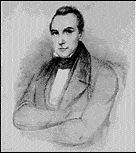 |
| A hundred years later, the analysis of logical operations,
started by George Boole, was much more advanced.
Electromagnetic relays could be used instead of gearwheels.
But no-one had advanced on Babbage's principle. Builders of
large calculators might put the program on a roll of punched
paper rather than cards, but the idea was the same: machinery
to do arithmetic, and instructions coded in some other form,
somewhere else, designed to make the machinery work.
To see how different this is from a computer, think of what
happens when you want a new piece of software. You can FTP it
from a remote source, and it is transmitted by the same means
as email or any other form of data. You may apply an UnStuffIt
or GZip program to it when it arrives, and this means
operating on the program you have ordered.
For filing, encoding, transmitting, copying, a program is no
different from any other kind of data — it is just a sequence
of electronic on-or-off states which lives on hard disk or RAM
along with everything else.
The people who built big electromachanical calculators in
the 1930s and 1940s didn't think of anything like this.
Even when they turned to electronics, they still thought of
programs as something quite different from numbers, and stored
them in quite a different, inflexible, way. So the ENIAC,
started in 1943, was a massive electronic calculating machine,
but I would not call it a computer in the modern sense.
Perhaps we could call it a near-computer.
|
More on near-computers, war and peaceThe Colossus was
also started in 1943 at Bletchley Park, heart of the British
attack on German ciphers (see this
Scrapbook page.)
I wouldn't call it a computer either, though some people
do: it was a machine specifically for breaking the "Fish"
ciphers, although by 1945 the programming had become very
sophisticated and flexible.
But the Colossus was crucial in showing Alan Turing the
speed and reliability of electronics. It was also ahead of
American technology, which only had the comparable ENIAC
calculator fully working in 1946, by which time its design was
completely obsolete. (And the Colossus played a part in
defeating Nazi Germany by reading Hitler's messages, whilst
the ENIAC did nothing in the war effort.)
1996 saw the fiftieth anniversary of the ENIAC. The
University of Pennsylvania and the Smithsonian
made a great deal of it as the "birth of the Information Age".
Vice-President Gore and other dignitaries were involved. Good
for them.
At Bletchley Park Museum, the Reconstruction
of the Colossus had to come from the curator Tony Sale's
individual efforts.
Americans and Brits do things differently. Some things
haven't changed in fifty years.
Another parallel figure, building near-computers, was Konrad
Zuse. Quite independently he designed mechanical
and electromechanical calculators, built in Germany before
and during the war. He didn't use electronics. He still had a
program on a paper tape. But he did see the importance of
programming and can be credited with the first programming
language, Plankalkul.
Konrad Zuse, 1910-1995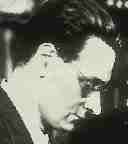 |
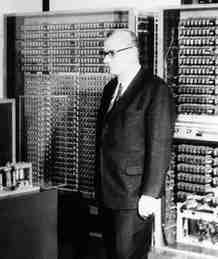 |
Like Turing, Zuse was an isolated innovator. But while
Turing was taken by the British government into the heart of
the Allied war effort, the German government declined Zuse's
offer to help with code-breaking machines.
The parallel between Turing and Zuse is explored by Thomas
Goldstrasz and Henrik Pantle.
Their work is influenced by the question: was the computer
the offspring of war? They conclude that the war hindered Zuse
and in no way helped.
In contrast, there can be no question that Alan Turing's
war experience was what made it possible for him to turn his
logical ideas into practical electronic machinery. This is a
great irony of history which forms the central part of his
story. He was the most civilian of people, an Anti-War
protester of 1933, very different in character from von
Neumann, who relished association with American military
power.
|
The Internally Stored Modifiable ProgramThe
breakthrough came through two sources in 1945:
- Alan Turing, with his own logical theory, and his
knowledge of the Colossus.
- the EDVAC report, by John von Neumann, but gathering a
great deal from ENIAC engineers Eckert and Mauchly
They both saw that the programs should be stored in
just the same way as data. Simple, in retrospect, but not at
all obvious at the time.
John von Neumann, 1903-1957John von Neumann
(originally Hungarian) was a major twentieth-century
mathematician with work in many fields unrelated to
computers.
|
 |
The EDVAC Report became well known and well publicised, and
is usually counted as the origin of the computer in the modern
sense. It was dated 30 June 1945 — before Turing's report was
written. It also bore von Neumann's name alone, denying proper
credit to Eckert and Mauchly who had already seen the
feasibility of storing instructions internally in mercury
delay lines. (This dispute has been brought again to public
attention in the book ENIAC
by Scott McCartney. This strongly contests the viewpoint put
by Herman Goldstine, von Neumann's mathematical colleague, in
The
Computer from Pascal to von
Neumann. )
However, what Alan Turing wrote in the autumn of 1945 was
independent of the EDVAC proposal, and it was much further
ahead.
That's because he based his ideas on what he had seen in
1936 — the concept of the universal machine. In the abstract
universal machine of 1936 the programs were written on the
store in just the same way as the data and the working. This
was no coincidence. Turing's discoveries in mathematical
logic, using the Turing machine concept, depended on seeing
that programs operating on numbers could
themselves be represented as numbers.
But Turing's 1945 conception of the computer was not tied
to numbers at all. It was for the logical manipulation of
symbols of any kind. From the start he stressed that a
universal machine could switch at a moment's notice from
arithmetic to the algebra of group theory, to chess playing,
or to data processing.
Von Neumann was in the business of calculating for the
atomic bomb and for artillery tables, concerned with doing
massive amounts of arithmetic. Alan Turing came fresh from
codebreaking, work on symbols which wasn't necessarily to do
with arithmetic. He had seen a vast establishment built up
with special machines organised to do different tasks. Now,
Turing saw, they could all be replaced by programs for a
single machine. Further, he saw immediately the first ideas of
programming structure and languages.
|
Computer History on the WebThe Computer Museum History
Center has an extensive overview of computer history.
There are several other pages with huge lists of links to
other pages of computer history. There are for instance
But you should watch out — a
great deal of published material is wrong or highly
misleading. An example would be the Turing
entry on Professor Lee's site, which also appears as a
resource in the Yahoo listing. This writer fails to
distinguish the Universal Turing machine from the general
Turing machine concept; he believes the Colossus was used by
Turing on the Enigma and was 'essentially a bunch of
servomotors and metal'...
Some typical on-line summaries
- Tools
for Thought, an on-line book by Howard Rheingold, gives
an integrated view of all these developments, very readable,
though with inaccuracies (saying the Colossus was used on
the Enigma).
- The IEEE
Computer Society timeline of computer history,
completely excluding mention of British developments and of
Alan Turing.
- An encyclopaedia
history with the standard American line: the link from
Babbage to the ENIAC, the transition to stored program made
by the EDVAC. No mention of Alan Turing, but it does mention
the Colossus. It points out that since the Colossus was kept
secret it had no influence — which, in America, was indeed
the case.
- Short
lectures by Michelle Hoyle, University of Regina.
Includes a greater variety of topics, including a
discussion of the Turing machine concept, but doesn't
integrate it into the historical development.
- This
'timeline' gives another example of the completely
muddled names and dates so often to be found in summaries of
computer history.
Behind these confusions lies a basic disagreement about
what whether the origin of the computer should be placed in a
list of physical objects — basically the
hardware engineers' viewpoint — or whether it it belongs to
the history of logical, mathematical and scientific
ideas, as logicians, mathematicians and software
engineers would see it.
I take the second viewpoint: the essential point of the
stored-program computer is that it is built it to embody and
implement a logical idea, Turing's idea: the Universal Turing
machine of 1936. Turing himself always referred to computers
(in the modern sense) as 'Practical Universal Computing
Machines'. |
So who invented the computer?There are many different
views on which aspects of the modern computer are the most
central or critical.
- Some people think that it's the idea of using
electronics for calculating — in which case another American
pioneer, Atanasoff,
should be credited.
- Other people say it's getting a computer actually built
and working. In that case it's either the tiny prototype at
Manchester (1948), on the next
Scrapbook Page, or the EDSAC at
Cambridge, England (1949), that deserves greatest attention.
But I would say that in 1945 Alan Turing alone grasped
everything that was to change computing completely after that
date: the universality of his design, the emphasis on
programming, the exploitation of the stored program, the
importance of non-numerical applications, the apparently
open-ended scope for mechanising intelligence. He did not do
so as an isolated dreamer, but as someone who knew about the
practicability of large-scale electronics, with hands-on
experience.
The idea of one machine for every kind of task was
very foreign to the world of 1945. Even ten years later, in
1956, the big chief of the electromagnetic relay calculator at
Harvard, Howard Aiken, could write:
If it should turn out that the basic logics
of a machine designed for the numerical solution of
differential equations coincide with the logics of a machine
intended to make bills for a department store, I would
regard this as the most amazing coincidence that I have ever
encountered.
But that is exactly how it has turned out. It
is amazing, although we now have come to take
it for granted. But it's not a mere coincidence. It follows
from the deep principle that Alan Turing saw in 1936: the
Universal Turing Machine. |
The Electronic Brain - what went wrong?So why isn't
Alan Turing famous as the inventor of the computer?
History is on the side of the winner. In 1945 Alan Turing
could have felt like a winner. He was taken on by the National Physical Laboratory
at Teddington, in London suburbs. His detailed plan for an
electronic computer, with a visionary prospectus for its
capacities, was accepted in March 1946. Everything seemed to
be going for it.
Well, not quite everything. Turing's plan called for at
least 6k bytes of storage, in modern terms, and this was
considered far too ambitious.
And the Colossus electronic engineers, now returned to the
Post Office, were unable to make a quick start on the plan as
he had expected.
In late 1946 the NPL put out press releases which made it
perfectly clear that Turing's design was seen as a major
national project and outstanding innovation.
|
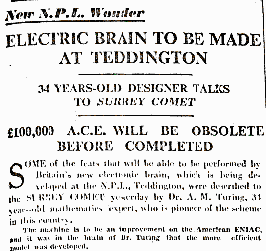 |
Some of the feats that
will be able to be performed by Britain's new
electronic brain, which is being developed at the
N.P.L., Teddington, were described to the SURREY COMET
yesterday by Dr. A. M. Turing, 34-year-old mathematics
expert, who is the pioneer of the scheme in this
country.
The machine is to be an improvement on the American
ENIAC, and it was in the brain of Dr Turing that the
more efficient model was developed....
From the local suburban newspaper, the Surrey Comet,
9 November 1946.
More text in my
book. | |
| But it was not to be. The rigid style of management meant
that nothing was built in 1947 or 1948 and virtually all his
ideas from this period, including the beginnings of a
programming language, were lost when he resigned from the NPL
in 1948. Another factor was that the complete secrecy about
the codebreaking operations meant that Turing could never draw
on his immense and successful experience, instead appearing as
a purely theoretical university mathematician.
Furthermore, he did not promote his ideas effectively. If
he had written papers on The Theory and Practice of Computing
in 1947, instead of going on to new ideas, he would have done
more for his reputation.
He didn't. He went running and he thought about what he saw
as the next step: Artificial Intelligence. Or rather, it was
for him not so much the next step, as the very thing which
made him interested in computers at all. The very idea of the
Turing machine in 1936 drew upon modelling the action of the
mind.
 |
The Runner UpAlan Turing got very
depressed and angry about the NPL, and losing a race
against time. But he eased his frustration by becoming a
world class distance runner.
Go to this
Scrapbook Page to see the marathon
man. |
After 1948 almost everyone forgot that he had drawn up the
design for a computer in 1945-6, the most detailed design then
in existence. The mathematician M. H. A. (Max) Newman, when
writing his Biographical Memoir of Turing in 1955, passed over
this period with the words,
...many circumstances combined to turn his
interest to the new automatic computing machines. They were
in principle realizations of [Turing's] 'universal
machine'... though their designers did not yet know of
Turing's work. How could Newman have
forgotten that Turing himself was such a designer — in fact
the author of the very first detailed design — and that
obviously he knew of his own work? Alan Turing's reputation
has been subject to a strange kind of selective memory. Now,
the computer itself can help put matters right before your
eyes.
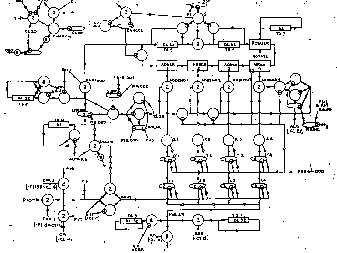
A page of detailed electronic design from
Turing's ACE report
|
Newman entirely neglected Turing's
origination of the computer, and this has done considerable
harm to Turing's subsequent reputation in computer science.
But his neglect reflects a pure mathematician's attitude which
perhaps holds a deeper truth. Newman's Biographical Memoir
lamented the fact that Turing was taken away from the
mathematics he was doing in 1938-39, his deepest work. He saw
the computer as a comparatively trivial offshoot, and a
diversion from what Turing should have done. Perhaps Turing
would have done something much greater had he followed the
Ordinal Logics work of 1938. Perhaps the war degraded his true
individual genius and left him doing things that others could
have done better. This is a point of view I now think I did
not give sufficient weight in my biography of
Turing. It is better reflected in my new text on Turing as
a philosopher.
After Turing resigned, a change in management at the NPL
meant that the ACE project could go ahead after all. A working
computer, based on his original design, was operating in 1950.
The 'Pilot
ACE' is now listed as one of the treasures of the Science Museum,
London. You can see it on the main ground
floor gallery of the Museum.
Alan Turing and the InternetAlan Turing proposed in
his 1946 report that it would be possible to use the ACE
computer by a remote user over a telephone link. So he foresaw
the combination of computing and telecommunications long
before others. He was never able to do anything about this,
but one of Turing's early colleagues at the NPL, Donald
W. Davies, went on to pioneer the principle of packet
switching and so the development of the ARPANET which led
to the Internet you are using now. |
| Meanwhile Alan Turing gave up on the NPL's slow procedures
and moved to Manchester in 1948.
The argument about who was first with the idea of the
computer continues there... |
| |